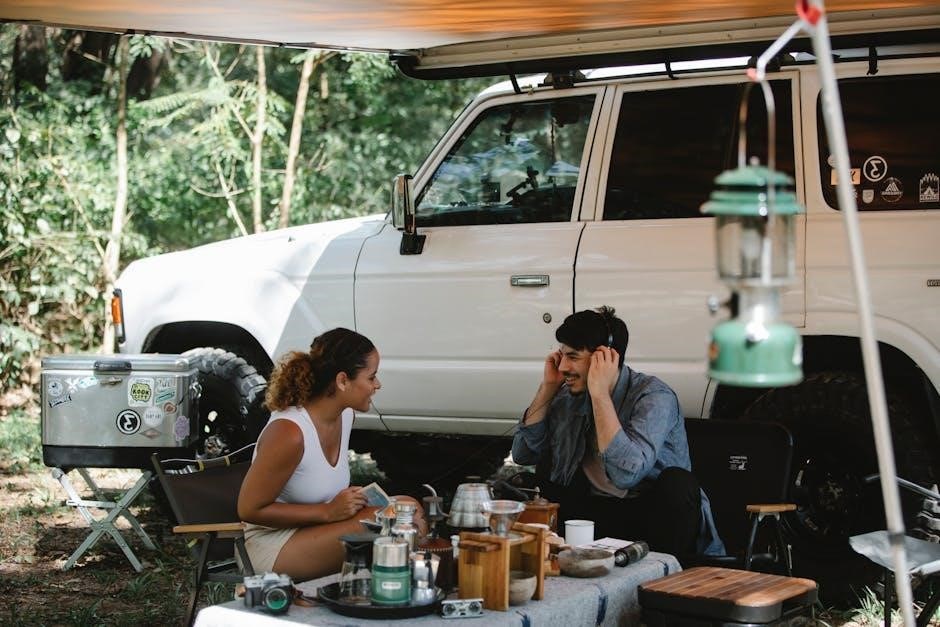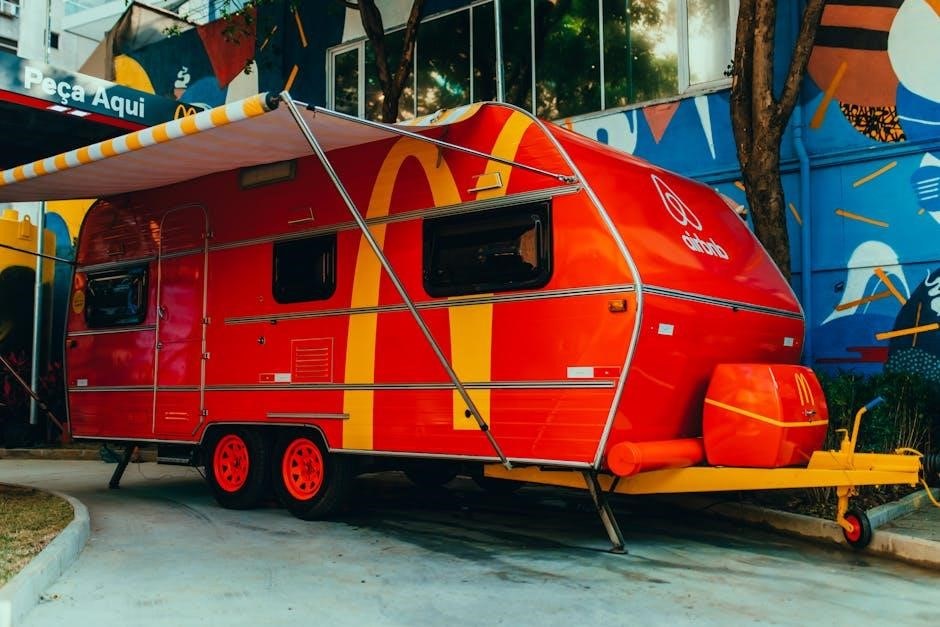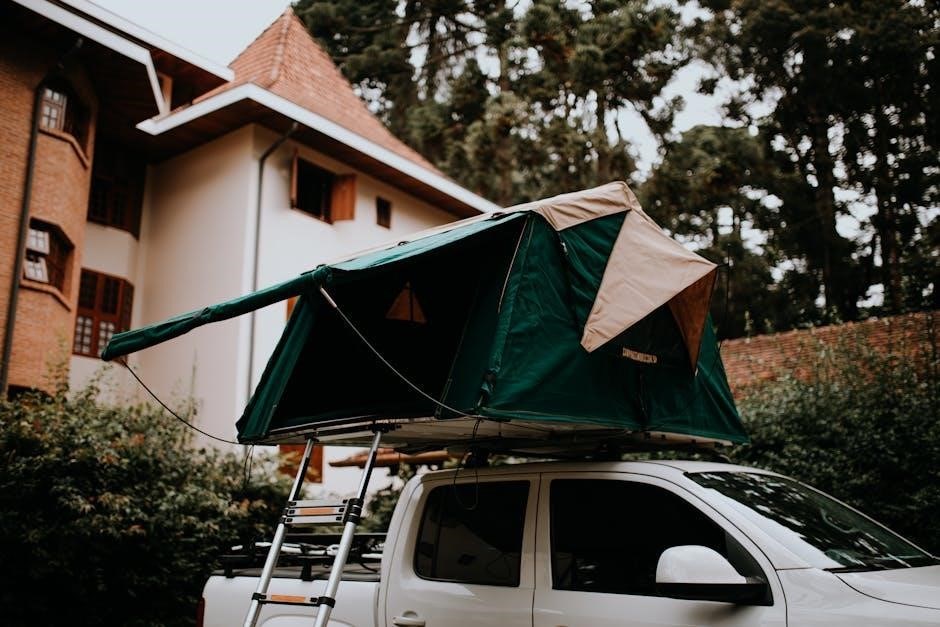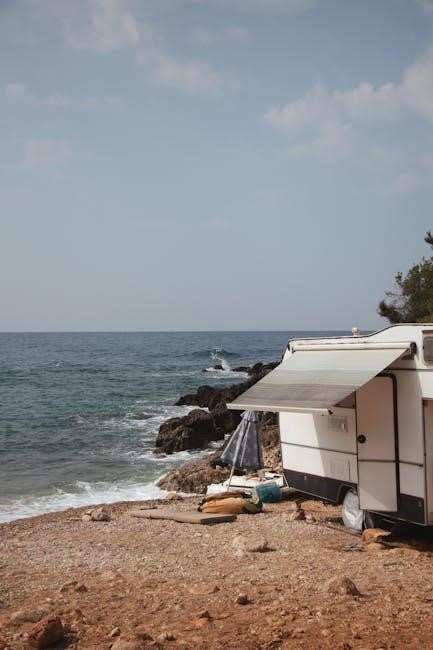Manual awnings for campers are retractable shade solutions designed to enhance outdoor living experiences. Made from durable materials like heavy-duty vinyl, they provide reliable shelter and UV protection.
These awnings are ideal for campers seeking a practical, cost-effective way to create shaded areas. They are easy to set up without electricity, making them perfect for off-grid adventures.
With sizes ranging from 8 to 21 feet, manual awnings cater to various camper types, ensuring versatility and comfort. Their lightweight, compact design makes them easy to transport and store.
Overview of Manual Awnings
Manual awnings are retractable shade systems designed for campers, offering a practical solution for outdoor protection. They are typically made from durable materials like heavy-duty vinyl, ensuring longevity and weather resistance. These awnings are easy to operate without electricity, making them ideal for off-grid adventures. Available in sizes from 8 to 21 feet, they cater to various camper types, providing customizable shade options. Their lightweight and compact design allows for easy transportation and storage. Manual awnings are a cost-effective way to enhance camping experiences, offering both functionality and style while protecting against sun, rain, and UV exposure.
Importance of Shade and Shelter for Campers
Shade and shelter are essential for campers to protect against harsh weather conditions. Manual awnings provide a reliable solution, offering UV protection and a dry space during rain. This creates a comfortable outdoor area for relaxation and dining, enhancing the camping experience. Additionally, awnings shield the camper’s interior from direct sunlight, reducing heat buildup and preventing furniture fading. By providing a shaded environment, they also help regulate the camper’s temperature, improving energy efficiency and reducing the need for air conditioning. This makes manual awnings a practical and beneficial investment for campers seeking comfort and protection in various outdoor settings.

Types of Manual Awnings for Campers
Manual awnings for campers come in various styles and materials, such as durable vinyl, offering sizes from 8 to 21 feet. Designed for functionality and style.
Manual vs. Electric Awnings
Manual and electric awnings cater to different camper needs. Manual awnings are cost-effective, easy to install, and ideal for those who prefer simplicity without electrical dependencies. They operate via a crank or strap system, offering a straightforward setup process. Electric awnings, while more convenient, require power and installation, making them less suitable for off-grid adventures. Manual awnings are lightweight, compact, and perfect for campers seeking reliability without the need for complex systems, ensuring a hassle-free outdoor experience. They are also more affordable and energy-efficient, appealing to budget-conscious travelers who value durability and ease of use.
Different Materials for Manual Awnings
Manual awnings for campers are crafted from durable materials to withstand outdoor conditions. Heavy-duty vinyl, such as 16 oz material, is a popular choice for its weather resistance and longevity. Fabric options like polyester and canvas are also used, offering UV protection and water resistance. Aluminum alloy frames provide strength and stability, ensuring the awning remains secure in windy conditions. These materials are designed to endure harsh weather, including rain, sun, and snow, while maintaining a sleek appearance. The combination of sturdy frames and high-quality fabrics ensures manual awnings are both functional and long-lasting, perfect for enhancing your camping experience.
Popular Sizes and Styles
Manual camper awnings are available in various sizes, ranging from 8 to 21 feet, to fit different camper types and needs. Compact 8-12 foot models are ideal for smaller campers and trailers, while larger 14-21 foot options suit motorhomes and fifth wheels. Traditional roll-out styles are the most common, offering easy setup and versatility. Dome-style awnings provide enhanced weather protection, while slide-out models are designed for RVs with slide-out sections. Many awnings come in multiple colors and patterns, allowing campers to customize their setup. This range ensures there’s a perfect fit for every camper, whether seeking shade, style, or durability.

Benefits of Using a Manual Awning

Manual awnings provide shade, weather protection, and energy efficiency, enhancing outdoor comfort. They are cost-effective, easy to use, and improve your camper’s functionality without electricity.
Shade and Weather Protection
Manual awnings provide excellent shade and weather protection, shielding campers from harsh sunlight, rain, and wind. Made from durable materials like heavy-duty vinyl, they ensure reliable coverage in various conditions.
These awnings are designed to create a comfortable outdoor space, protecting both people and interiors from UV rays and moisture. Their sturdy construction withstands outdoor elements, offering long-lasting performance and peace of mind for campers.
With sizes ranging from 8 to 21 feet, manual awnings can cover large areas, providing ample shelter. They are easy to set up manually, eliminating the need for electricity, making them ideal for off-grid adventures and ensuring consistent weather protection wherever you camp.
Energy Efficiency and Cost-Effectiveness
Manual awnings are energy-efficient and cost-effective solutions for campers. They operate without electricity, reducing power consumption and reliance on generators or batteries, making them ideal for off-grid adventures. This eco-friendly design lowers energy costs and prolongs battery life for solar-powered setups. Additionally, manual awnings are often more affordable than electric models, offering significant savings on initial purchases and maintenance. Their simplicity reduces the risk of mechanical failures, further lowering long-term costs. Durable materials like heavy-duty vinyl ensure longevity, minimizing the need for frequent replacements. Brands like Awnlux provide budget-friendly options without compromising on quality, making manual awnings a practical choice for campers seeking efficiency and value.
Enhanced Outdoor Living Experience
Manual awnings significantly enhance the outdoor living experience for campers by providing a comfortable, shaded area perfect for relaxation and entertainment. They create a cozy space outside the camper, shielding from harsh sunlight, rain, and wind. This extension of living space allows campers to enjoy nature without compromising on comfort. With customizable sizes and colors, manual awnings blend seamlessly with camper aesthetics. Their durability ensures they withstand various weather conditions, offering reliable protection. Easy setup and takedown make them ideal for spontaneous adventures. By expanding your living area, manual awnings help create lasting memories, making every camping trip more enjoyable and stress-free.
Compact and Lightweight Design
Manual camper awnings are designed to be compact and lightweight, making them easy to transport and store. Their retractable nature allows for minimal space consumption when not in use. Constructed from durable yet lightweight materials, such as aluminum frames and weather-resistant fabrics, these awnings provide reliability without adding excessive weight to your camper. Their portability ensures they can be easily set up and taken down, offering convenience for campers on the go. The sleek design also complements the camper’s exterior, ensuring a seamless appearance. This combination of practicality and aesthetics makes manual awnings an ideal choice for enhancing your camping experience without compromising on mobility or storage space.

Choosing the Right Manual Awning for Your Camper
Selecting the right manual awning involves assessing your camper’s size, material preferences, and needed features like wind resistance. Top brands offer durable, easy-to-use options.
Consider Your Camper’s Size and Type
When choosing a manual awning, it’s essential to consider your camper’s size and type. Measure your camper’s length to ensure the awning fits properly, typically ranging from 8 to 21 feet.
Motorhomes, travel trailers, and 5th wheels have different installation requirements. Ensure the awning is compatible with your camper’s roof height and door placement for proper clearance.
Lightweight campers may benefit from smaller, portable awnings, while larger RVs require sturdier models. Always check weight limits and mounting options to avoid structural strain.
Consult manufacturer guidelines to match your camper’s specific needs, ensuring a secure and functional fit for optimal shade and protection during your adventures.
Selecting the Right Material and Color
Choosing the right material and color for your manual camper awning is crucial for durability and aesthetics. Opt for heavy-duty vinyl or polyester fabrics, known for their weather resistance and UV protection.
Lighter colors like white or beige reflect sunlight, reducing heat absorption, while darker shades offer a sleek appearance. Consider matching your awning color to your camper’s exterior for a cohesive look.
Materials like aluminum alloy frames ensure stability and longevity. Ensure the fabric is tear-resistant and designed for outdoor use. Selecting the right combination enhances both functionality and visual appeal for your camping adventures.
Key Features to Look For
When selecting a manual awning for your camper, prioritize features that enhance durability and functionality. Look for heavy-duty materials like 16-19 oz vinyl or polyester for weather resistance and UV protection.
Ensure the awning has a sturdy frame, such as aluminum alloy, for stability. Adjustable sizing and easy setup mechanisms are essential for convenience. Wind-resistant designs and customizable colors add practicality and style.
Additional features like pre-assembled parts, video tutorials, and compatibility with various camper types can simplify installation. Durable stitching and tear-resistant fabric ensure longevity, making your awning a reliable shelter for years of camping adventures.
Top Brands and Their Offerings

Prominent brands like Awnlux, Dometic, and Carefree offer high-quality manual camper awnings. Awnlux provides durable 16-19 oz vinyl options in various sizes and colors, while Dometic’s classic manual awnings are known for reliability and style.
ShadePro and RecPro also stand out, offering weather-resistant and UV-protected designs. Lippert and Solera provide affordable, easy-to-install solutions. These brands ensure campers enjoy shade, shelter, and comfort with their expertly crafted awnings.

Each brand caters to different camper needs, from compact setups to large family RVs, ensuring a perfect fit for any adventure.

Installation and Setup of Manual Awnings
Manual awnings come with pre-assembled frames and video tutorials, simplifying the installation process. Mounting brackets are attached to the camper, ensuring a secure and proper fit.
Step-by-Step Installation Guide
Begin by attaching the mounting brackets to your camper using the provided hardware, ensuring they are securely fastened. Next, assemble the awning frame according to the manufacturer’s instructions, typically requiring no special tools. Attach the fabric to the frame, making sure it is tightly secured to prevent sagging or flapping. Finally, install the manual operation mechanism, such as a crank or strap, to allow easy extension and retraction of the awning. Follow the included video tutorials or written guides for precise alignment and proper functionality.
Tools and Accessories Needed
For installing a manual camper awning, essential tools include a drill, screwdrivers, wrenches, and a measuring tape. Accessories like mounting brackets, screws, and weatherproof seals are also required. Additionally, straps, knobs, and a crank or handle are necessary for operation. A cleaning kit and fabric protector can help maintain the awning’s condition; Ensure all components are included in the kit or purchase separately as needed. Proper tools and accessories ensure a secure, functional, and long-lasting setup for your camper awning.
DIY vs. Professional Installation
Installing a manual camper awning can be a DIY project with the right tools and instructions. Many kits come with pre-assembled frames and video tutorials, making it manageable for homeowners. However, for those less handy, professional installation ensures a secure and proper fit. Professionals handle complex setups, especially for larger awnings or unique camper designs. DIY saves money but requires time and effort, while professional services offer peace of mind and warranty coverage. Choose based on your skill level and the awning’s complexity to ensure optimal performance and longevity. Proper installation is key to enjoying your camper awning’s benefits.

Maintenance and Care Tips
Regularly clean the awning fabric and allow it to dry before storage. Protect it from harsh weather conditions to ensure durability and longevity of the material.
Cleaning and Storing the Awning
Regularly clean the awning fabric using mild soap and water to remove dirt and stains. Avoid harsh detergents that may damage the material. Rinse thoroughly and allow it to air dry completely before storing. When storing, ensure the awning is dry and free of debris to prevent mildew. Store it in a shaded, dry area away from direct sunlight and moisture. For extended storage, consider using a protective cover to shield it from dust and pests. Always inspect the fabric for damage before storing and repair any tears or worn areas to maintain its durability and performance.
Regular Inspections and Repairs
Regular inspections are crucial to maintain the durability of your manual awning. Start by examining the fabric for tears, fading, or mildew. Check the hardware, such as arms and brackets, for signs of wear or rust. Lubricate moving parts to ensure smooth operation. Address any damage promptly to prevent further issues. For minor tears, use a patch kit specifically designed for awning fabric. If repairs are beyond your expertise, consult a professional. Regular maintenance ensures your awning remains functional and continues to provide reliable shade and shelter during your camping trips. Always follow the manufacturer’s guidelines for repairs and replacements.
Protecting the Awning from Harsh Weather
Protecting your manual awning from harsh weather is essential to extend its lifespan. Always retract the awning during strong winds or storms to prevent damage from gusts. Ensure it is securely fastened to avoid flapping, which can cause tears. After exposure to rain or snow, clean the awning to remove dirt and debris that may cause wear. Apply a waterproof treatment to the fabric for added protection. Store the awning in a dry, shaded area during extreme weather conditions. For long-term storage, use a protective cover to shield it from UV rays and moisture. Regular care ensures your awning remains durable and reliable for future adventures.

Troubleshooting Common Issues
Common issues with manual awnings include fabric tears, mechanical malfunctions, and difficulties in retracting. Address these by inspecting for damage, lubricating moving parts, and ensuring proper setup and maintenance.
Addressing Fabric Damage and Tears
Fabric damage and tears on manual awnings can compromise their functionality and durability. Regular inspections are crucial to identify and address issues early. For minor tears, use a high-quality repair kit specifically designed for awning fabrics. Clean the area thoroughly before applying adhesive patches to ensure a strong bond. For larger damages, professional repair or replacement may be necessary. Preventative measures include avoiding sharp objects, keeping the awning clean, and storing it properly when not in use. Regular maintenance ensures your manual awning remains in optimal condition, providing reliable shade and weather protection for your camping adventures.
Fixing Mechanical Malfunctions
Mechanical malfunctions in manual awnings often involve issues with the arms, springs, or mounting hardware. Start by loosening any tight knobs or adjusting the tension to ensure smooth operation. Lubricate moving parts to eliminate friction and prevent corrosion. If the awning fails to extend or retract properly, inspect the springs for damage and replace them if necessary. Ensure all bolts and screws are securely tightened to avoid wobbling. For complex issues, refer to the manufacturer’s guide or seek professional assistance. Regular maintenance and timely repairs will extend the lifespan of your manual awning and maintain its reliability during camping trips.
Manual awnings for campers offer a perfect blend of functionality and style, enhancing outdoor experiences with reliable shade and protection. A worthwhile investment for any camper seeking comfort and convenience.
Final Thoughts on Manual Awnings
Encouragement to Upgrade Your Camper
Upgrading your camper with a manual awning is a smart investment for any outdoor enthusiast. These awnings offer durable construction, easy setup, and versatile sizing to suit your needs. By adding a manual awning, you enhance your camping experience with reliable shade and shelter, protecting you from sun, rain, and snow. It’s a practical way to elevate your outdoor adventures, ensuring comfort and style. Don’t miss out on the opportunity to create lasting memories with a high-quality manual awning designed to withstand the elements and provide years of reliable service.
